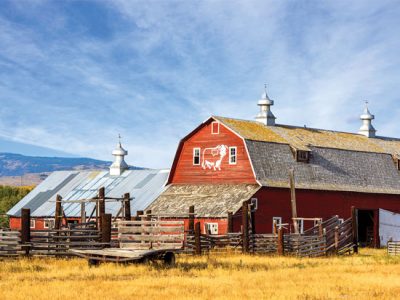Sprawling throughout the rural American landscape are iconic symbols of our forefathers’ tireless hard work and ingenuity: the American barn, in all shapes, sizes, and variations — modern-day pyramids built by our agricultural ancestors. Despite their rich legacies and strong timber frames, so many of these structures have been left empty, doors loose in the wind, as new generations head to the city and abandon the old family farm.
When my partner and I took on restoring our late-1800s Yankee barn, we had no idea how much history would pass through our hands. We had only begun to appreciate the amount of labor that had gone into its original construction. These seemingly simple structures were precisely crafted to fit the needs of the farmer and the farm. And spanning the history of American geography, they have changed to suit the trends of farming.
The humble beginnings of the American barn
The first barns were not American by design, but were European-style longhouses that included stables and sleeping quarters. Builders utilized skills many had learned in creating the arching hallways of cathedrals to create roomy and functional farm outbuildings. Brought to America along with the first settlers, the oldest style of barn still graces our landscapes in the classic “English barn” style.
English-style barns were built from the 1600s through the 1800s, and had a large, open central floor for wheat threshing. On either side of the floor were small stabling areas for the family horse and hay storage. As grain production was the principle focus of the first American farmers, the English barn was designed with the largest area of space dedicated to threshing with few or no windows, and only a single door on the long side of the barn. In fact, it was not until the 1800s that the connection between plentiful light and healthy farm animals was made and windows became more common.
Most farmers were not then, and are not today, professional carpenters. One of the most fascinating aspects of barn construction is the common use of simple farmstead creativity. A barn’s construction often revolved around the farmer’s schedule, which was always full, and his skill level, which was untrained yet honed by years of providing for himself and his family. Building a barn could take years, with frames being laid out by one generation, while the next put the final hinges on the doors.
Changing times
As with any structure built for functionality, this design did not follow one pattern for long. By the mid-1800s, the English style was being adapted and changed to suit the changing nature of agriculture. The first major change was the addition of basements. Farmers began building barns on hillsides to allow for a full basement with lower-level ground access on one side, while the uphill side allowed upper-level access to the first floor. This particular style, called a bank barn, was developed to be most efficient during harvest time. A hay wagon could be driven into the central bay on the upper level and unloaded without the need for an elevator. Soon, basements were being used as a place to let manure turn to compost, as well as housing for some of the animals.
Bank barns had one major downside, especially when their lower level was being used for manure storage. They held moisture, which would rot the beams of the barn and fill the building with the odors of compost. To combat these issues, farmers began adding cupolas and other ventilation systems, along with windows to allow for more light, both of which contributed to livestock health.
In New England, English barns were further adapted into larger, timber-framed structures, which became known as the Yankee barn. Yankee barns have large sliding doors on either of the gable ends, with large areas for livestock on either side of a central hallway. Overhead lofts allowed for convenient hay storage, and oftentimes basements were added in the bank barn style.
Yankee barns, also called New England barns, allowed for more cattle to be housed, and were the first step in a continuing trend of larger barns to accommodate more animals. By the late 1800s, cattle were becoming the “crop,” as more of the population demanded fresh dairy and beef. Until this point, the largest crop for a farmer was wheat, while livestock was limited to only what the family needed for meat, milk, and transportation.
Style variety of American barns

As New England farmers were building bigger barns, those in other parts of the country were also feeling the need to house more livestock. The Pennsylvania Dutch had their own unique take on the barn, with longer, lower roofs and gable end doors. As cattle farming became more mainstream, they heightened the roofs, and some rounded them to allow for more hay storage. They are also distinguished by the use of folk art symbols, known as hex signs, painted on barn walls.
In similar fashion, to accommodate for keeping more cattle and other livestock, and hay to feed them, the prairie barn, or Western barn, was popular among settlers of the 1800s. Those moving out West would often build barns with high, steep roofs that allowed for plenty of storage space and a central hallway.
German settlers built a type of barn called the “crib barn,” mostly used to store corn. A common sight in Appalachia, crib barns would be simple structures made of rough, round logs, with no closing doors. In the Deep South, a common design was an open barn for good ventilation with no stalls and racks for hanging tobacco. In the northern most towns of Maine, a style of two large barns joined together in the middle to form an “H” was called a Madawaska twin barn.
In New England, a particular style of building was common among small family farms. Having built a house and a barn, farmers would find themselves adding other outbuildings, including a woodshed, chicken coop, garden shed, and workshop. Harsh northern winters brought these outbuildings closer to the main house until they were all connected, allowing the farmer to stay inside during all daily chores. The connected barn, also called the “connected farm,” became so popular that there was a nursery rhyme about them: “big house, little house, back house, barn.” The style lost its appeal for reasons of sanitation, and because if a single building caught fire, the entire homestead would be lost.
Finding the perfect fit

Since the late 1700s, the farming community experimented with round barns. In the early 1900s, the Shakers made an effort to make the round barn the quintessential farm structure. In theory, round barns were the epitome of efficiency. With cattle stalls around the ground floor, livestock faced inward and hay could be dropped from haylofts above to a central feeder accessible to all livestock. Walkways on both floors allowed for easy maintenance and milking. Conventional farmers were skeptical, though, foreseeing higher building costs to add the abnormal building to their farm.
As barns and cattle operations grew, sanitation and keeping animals healthy became an issue. At the turn of the 20th century, this largely influenced the way barns were built. Storing manure in the same building as livestock caused foul fumes, and dark, windowless barns became home to disease. Cupolas, windows, and wider doors were added, and instead of wood or dirt floors, concrete became more common. Concrete flooring was crucial to the expansion of dairy operations across America, as it is easier to clean, and floors can be hosed and scrubbed to a clinically clean condition. The country farmer was quick to adapt. Along with providing better living conditions for the animals, the material was inexpensive and easier to install than wood flooring.
To allow more space for livestock, and to keep materials separate and sanitary, outbuildings began taking the place of dedicated areas in the barn for farm-related needs. Granaries, ice houses, milk houses, and hay barns emerged on the property to allow storage away from primary barn space.
By the early 1900s, America was on trajectory for the huge dairy operations that we see today. Silos were built to store grain, and inexpensive, lightweight vinyl siding replaced heavy and more costly wooden clapboards. Large gambrel roofs with cupolas and dormer windows allowed for improved airflow and better ventilation. Ground-level windows ran along the sides, and oftentimes folks built into a hillside for a bank design.

A place in time
When you find an old barn, you might be curious where it falls into the history of American barn building. Once you have identified the category, be it an old English, distinctive Dutch, or large Yankee barn, take a closer look at how the timbers are cut and fitted together. The earliest barns are built with timbers hand-hewn to shape, and you can see the rough chopping marks of an axe. Slightly older timbers might be hand-cut with huge two-person saws, while newer barns have the clean-cut lines of sawmill machinery.

Because they were hand-hewn, the first barns were fit together with precision. Joints were built specifically to match each other, and each mortise and tenon joint was unique. To solve this problem, each joint was marked with carved Roman numerals, denoting its place in the larger frame. These numbers typically mark a barn as pre-1900.
For most of American history, barns were the center of farm life, and still are for many families today. As Eric Sloan describes in his book An Age of Barns, barns are “the palaces of America.” Today, many of these grand structures are falling into disrepair as farmers turn their tractors in for sedans. The best way to pay respect to these palaces is to keep them maintained and put them to work.
Determine whether the old barn on your property is worth saving or salvaging for lumber.
Kirsten Lie-Nielsen is a freelance writer and farmer from Liberty, Maine. She is currently restoring a 200-year-old barn and farmhouse, while tending to geese, chickens, and goats. She blogs at Hostile Valley Farm (www.HostileValleyLiving.com), and hopes to help others learn about self-reliance and simple living.







